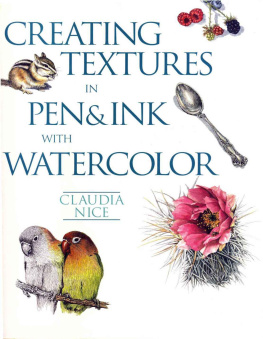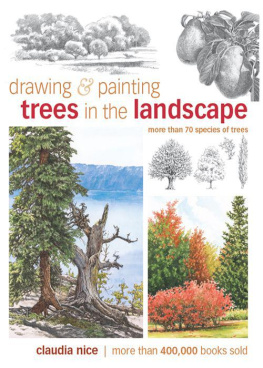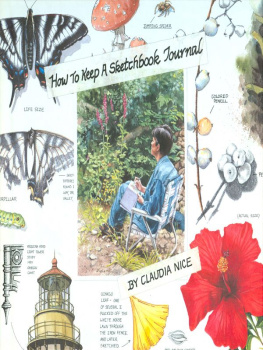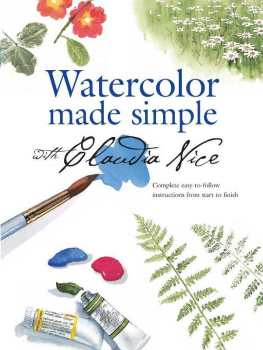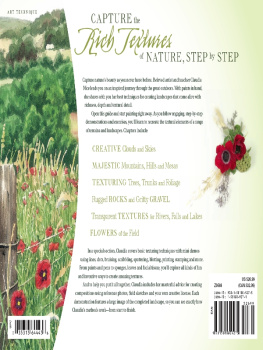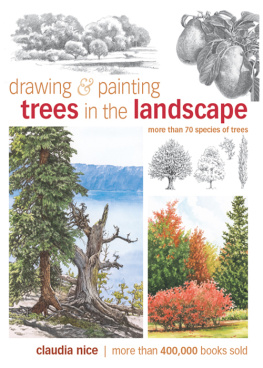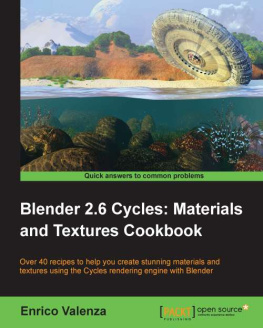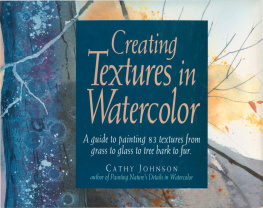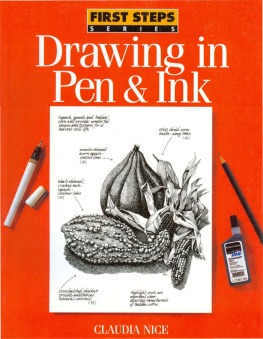
AUTUMN TEXTURE, 10 7, Watercolor, pen & ink, pen & ArtistColor.
CREATING
TEXTURES
IN
PEN&INK
WITH
WATERCOLOR
CLAUDIA
NICE


I dedicate this book with love to my parents. To my father who passed to me his creativity, and taught me to love nature from the business end of a fishing pole.
To my mother who read to me and instilled in my mind the love of good books, and a colorful imagination with which to create my own.
Above all, I dedicate this book to my creator who answered many prayers and made all things possible.
Thank you, Jim, for your patience, encouragement and support.

Contents












REEF FISH, 912 7, Watercolor textured with colored pen work.
INTRODUCTION
I first learned to appreciate texture as a pen-and-ink artist. Value contrasts and texture are the heart of an ink drawing. I discovered that stippled dots could become gritty sand or a velvety horse muzzle. Thick tangled foliage, flowing water, soft rabbit fur, weathered wood and the leathery folds of elephant skin could all be depicted with the stroke of a pen. I was hooked, but I missed the colorful vibrance of paint. A dew-dappled flower petal or the misty arch of a rainbow needed color to be at its glorious best. The solution was to combine the best of both mediums. The result: some really fun and exciting mixed media techniques. A lot of them were old standards. Salt techniques have been around almost as long as watercolor. However, it took a lucky accident to reveal to me what happens when rock salt falls into water and bounces into a wet washa lacy sea anemone is born. Ink stippling over a bump-shaped, washed area becomes coral with personality. A bit of alcohol spatter tucked between layers of sea-green watercolor brings an otherwise dull background to life. I now have a colorful reef scene with texture, as you can see on the facing page!
The knowledge of many watercolorists, months of experimentation, and dozens of accidents, both good and bad, have combined to become the techniques I share with you in this book. I have only touched the surface. There are vast combinations of mixed media textures waiting to be tried and appreciated. Armed with a pen, brush and the spirit of adventure, the next textural discovery could be yours.
Happy Texturing.


GATHERING RUST, 934 734, Watercolor, pen & ink, pen & ArtistColor.
CHAPTER ONE
MATERIALS
THE TECHNICAL PEN
The technical pen is an advanced drawing instrument consisting of a hollow nib, a self-contained ink supply and a plastic holder. Within the hollow nib is a delicate wire (which should not be removed from the nib); and a weight, which shifts back and forth during use, brings the ink supply forward. An ideal pen has a steady, leakfree flow and a precise nib that can be stroked in all directions.
With proper use and maintenance, the technical pen is the answer to the perfect art pen. I find I am most comfortable using a Koh-I-Noor Rapidograph. It is dependable and the refillable cartridge allows me to choose my own ink or colored medium.
Technical pens come in various nib sizes, ranging from very fine to extra broad. The line width chart at right shows both the Rapidograph nib sizes and their equivalent metric line widths. For a first pen, I recommend nib size 3 0/.25mm. Most of the detail work shown in the illustrations in this book were created using a 3 0 sized pen. I have indicated the sizes of the Rapidograph pens I used on many of the projects by placing the numbers in parentheses beside the sketches.

TECHNICAL PEN
PEN USE AND MAINTENANCE
Hold the pen as you would a pencil, keeping the angle rather upright. Use a steady, light pressure, maintaining good contact with the drawing surface.
Do not shake the technical pen! Shaking tends to flood the air channel with ink, creating a vacuum that prevents ink flow. If ink flow stops suddenly, try tapping the end of the pen holder (nib pointing skyward) against the table.
Keep the pen cap on when not in use. Wipe the nib often using a lint-free cloth when working over watercolor paint. Clean the pen thoroughly, following the manufacturer's instructions, at least once a month, or when changing inks or colored mediums.
For a more complete reference on using the Rapidograph penmaintenance, textural stroking, and various styles and techniquesrefer to Sketching Your Favorite Subjects in Pen & Ink, by Claudia Nice (North Light Books, 1993).
THE CROW QUILL
The crow quill dip pen consists of a wooden or plastic holder and a removable steel nib. With Hunt nibs no. 102 (medium) and no. 104 (fine), the crow quill will provide a good ink line. The tool cleans up easily and is inexpensive. It's useful for applying colored mediums when you desire many color changes or wish to add a finishing touch without filling a Rapidograph. Final touches of liquid acrylic were applied to . However, crow quills are limited in stroke direction, with a tendency to drip and splatter, and the redipping process interrupts the stroking rhythm.
Next page
